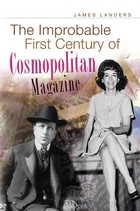2 books about Landers, James

The Improbable First Century of Cosmopolitan Magazine
James Landers
University of Missouri Press, 2010
Today, monthly issues of Cosmopolitan magazine scream out to readers from checkout counters and newsstands. With bright covers and bold, sexy headlines, this famous periodical targets young, single women aspiring to become the quintessential “Cosmo girl.” Cosmopolitan is known for its vivacious character and frank, explicit attitude toward sex, yet because of its reputation, many people don’t realize that the magazine has undergone many incarnations before its current one, including family literary magazine and muckraking investigative journal, and all are presented in The Improbable First Century of Cosmopolitan Magazine. The book boasts one particularly impressive contributor: Helen Gurley Brown herself, who rarely grants interviews but spoke and corresponded with James Landers to aid in his research.
When launched in 1886, Cosmopolitan was a family literary magazine that published quality fiction, children’s stories, and homemaking tips. In 1889 it was rescued from bankruptcy by wealthy entrepreneur John Brisben Walker, who introduced illustrations and attracted writers such as Mark Twain, Willa Cather, and H. G. Wells. Then, when newspaper magnate William Randolph Hearst purchased Cosmopolitan in 1905, he turned it into a purveyor of exposé journalism to aid his personal political pursuits. But when Hearst abandoned those ambitions, he changed the magazine in the 1920s back to a fiction periodical featuring leading writers such as Theodore Dreiser, Sinclair Lewis, and William Somerset Maugham. His approach garnered success by the 1930s, but poor editing sunk Cosmo’s readership as decades went on. By the mid-1960s executives considered letting Cosmopolitan die, but Helen Gurley Brown, an ambitious and savvy businesswoman, submitted a plan for a dramatic editorial makeover. Gurley Brown took the helm and saved Cosmopolitan by publishing articles about topics other women’s magazines avoided. Twenty years later, when the magazine ended its first century, Cosmopolitan was the profit center of the Hearst Corporation and a culturally significant force in young women’s lives.
The Improbable First Century of Cosmopolitan Magazine explores how Cosmopolitan survived three near-death experiences to become one of the most dynamic and successful magazines of the twentieth century. Landers uses a wealth of primary source materials to place this important magazine in the context of history and depict how it became the cultural touchstone it is today. This book will be of interest not only to modern Cosmo aficionadas but also to journalism students, news historians, and anyone interested in publishing.
[more]

The Weekly War
Newsmagazines and Vietnam
James Landers
University of Missouri Press, 2004
In The Weekly War, James Landers provides the first in-depth investigation of how the three major newsmagazines—Newsweek, Time, and U.S. News & World Report—covered the Vietnam War and the impact their coverage had on the American public, presidents, and policymakers. From March 1965 through January 1973 these magazines reached nearly one-third of adult Americans—second only to news programs on network television. Despite the popular impression that this was primarily a “television war,” the newsmagazines played a prominent role in informing the public about warfare and war policy.
While television reporting provided a here-and-now version of events, these magazines published articles that combined on-the-scene coverage with analysis and commentary. Because these publications worked on a more leisurely weekly deadline as opposed to the daily deadlines of television or newspapers, they were able to provide distinct perspectives on the week’s events, along with factual material. The writing was typically more vivid and detailed than that of newspapers, and the occasional use of color photographs contributed to the impact of the stories.
Each magazine had its own niche and distinct editorial style: Newsweek provided a mainstream liberal perspective, while Time took a more conservative viewpoint and U.S. News & World Report had an ultraconservative outlook. The editors of each magazine aimed to reach like-minded readers, knowing full well that a reader who disliked one magazine could simply switch to another. Landers demonstrates how public-opinion shifts during the war forced the newsmagazines, especially Time, to change too.
This book reflects a thorough examination of roughly nine hundred articles on the Vietnam War published by the three major newsmagazines. Landers also gathered documents from the Lyndon Baines Johnson Library and Richard M. Nixon Presidential Materials Project to reveal the attention paid to the newsmagazines by presidents and policymakers and their attempts to influence or manipulate coverage.
In addition to making a major contribution to the history of print journalism, The Weekly War complements scholarship on television news coverage of the Vietnam War. This volume will appeal to students and teachers of history and journalism, as well as the general reader interested in a unique view of the Vietnam War.
[more]
READERS
Browse our collection.
PUBLISHERS
See BiblioVault's publisher services.
STUDENT SERVICES
Files for college accessibility offices.
UChicago Accessibility Resources
home | accessibility | search | about | contact us
BiblioVault ® 2001 - 2024
The University of Chicago Press









